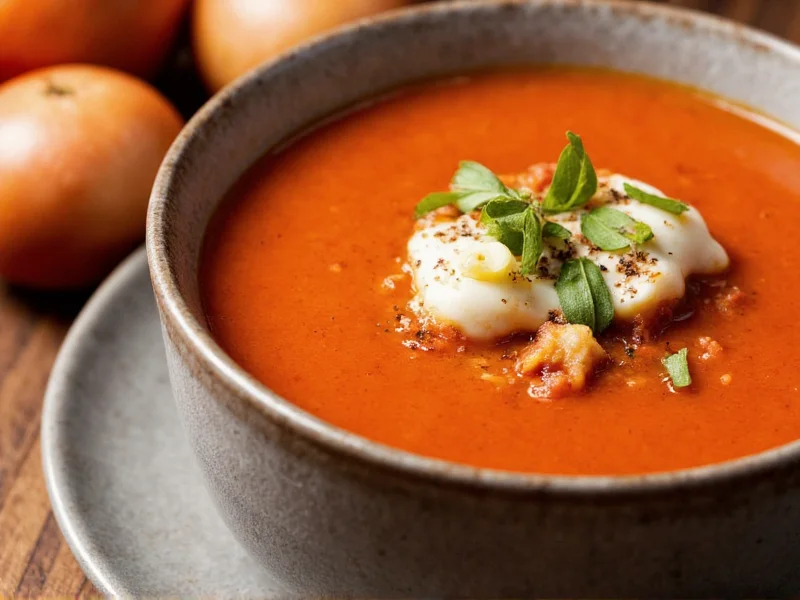For home cooks seeking restaurant-quality tomato soup, the baked method represents a culinary revelation. This technique leverages dry heat to intensify flavors in ways that boiling or simmering cannot match. When tomatoes roast in the oven, their cellular structure breaks down gradually, releasing juices that reduce and concentrate while the natural sugars caramelize. The result? A baked tomato soup with profound depth that requires fewer additional ingredients to achieve balanced flavor.
The Science Behind Superior Flavor Development
Understanding why baked tomato soup outperforms stovetop versions requires examining basic food chemistry. The Maillard reaction—that magical browning process occurring between amino acids and reducing sugars at temperatures above 285°F (140°C)—creates hundreds of new flavor compounds during baking. Simultaneously, the oven's dry heat evaporates excess water content, naturally concentrating the tomato's glutamates that enhance umami perception.
Research from the Journal of Food Science demonstrates that baking tomatoes increases lycopene bioavailability by 164% compared to raw consumption, while reducing perceived acidity through sugar concentration. This chemical transformation explains why properly executed baked tomato soup needs minimal added sweeteners—the tomatoes' natural fructose caramelizes into complex flavor compounds during the roasting process.
Essential Equipment and Ingredient Selection
While the baked tomato soup method appears straightforward, ingredient quality and equipment choices significantly impact results. Consider these critical factors:
| Component | Critical Selection Criteria | Why It Matters |
|---|---|---|
| Tomato Variety | Roma or San Marzano (low moisture, high solids) | Concentrates flavor faster with less liquid to reduce |
| Baking Dish | Heavy ceramic or cast iron (not glass) | Radiates heat evenly for consistent caramelization |
| Acid Component | Sherry vinegar (not lemon juice) | Complements roasted notes without sharp acidity |
| Umami Boosters | Sun-dried tomatoes + Parmesan rind | Enhances natural glutamates without overpowering |
Professional-Grade Baked Tomato Soup Recipe
This refined baked tomato soup recipe balances scientific precision with accessible home cooking techniques. The method produces a velvety texture without cream while maximizing flavor development through controlled caramelization.
Core Ingredients
- 3 lbs (1.4 kg) ripe Roma tomatoes, halved lengthwise
- 1 large yellow onion, sliced into 1/2-inch rounds
- 6 garlic cloves, unpeeled
- 3 tbsp extra-virgin olive oil
- 2 tbsp tomato paste
- 1/4 cup fresh basil, plus extra for garnish
- 1 Parmesan cheese rind (optional but recommended)
- 1 1/2 cups vegetable broth (low sodium)
- 1 tbsp sherry vinegar
Step-by-Step Method
- Preheat oven to 400°F (200°C) with rack positioned in center
- Arrange tomatoes cut-side up on baking sheet, nestling onions and garlic among them
- Drizzle with olive oil, sprinkle with 1 tsp salt and 1/2 tsp black pepper
- Bake 45-60 minutes until tomatoes collapse and edges brown deeply
- Transfer roasted vegetables to heavy pot, add tomato paste and stir 2 minutes
- Pour in broth, add Parmesan rind and basil, simmer 20 minutes
- Remove rind and garlic skins, blend until smooth with immersion blender
- Stir in sherry vinegar, adjust seasoning, and serve
Advanced Techniques for Flavor Optimization
Professional chefs employ several nuanced techniques when preparing baked tomato soup that home cooks can easily adopt:
Temperature Layering
Begin roasting at 425°F (220°C) for 20 minutes to initiate rapid caramelization, then reduce to 375°F (190°C) for remaining time. This two-stage approach prevents exterior burning while ensuring complete interior roasting.
Acid Timing
Add vinegar after blending rather than during cooking. Heat degrades delicate volatile compounds in vinegars, so late addition preserves bright notes that balance the soup's richness. For baked tomato soup with fresh basil, add half the herbs before baking and half after blending to capture both roasted and fresh aromatic profiles.
Variations for Dietary Needs
This versatile baked tomato soup method adapts beautifully to various dietary requirements without sacrificing flavor complexity:
- Vegan version: Replace Parmesan rind with 1 tsp nutritional yeast and 1/2 tsp mushroom powder for comparable umami depth
- Low-FODMAP option: Omit garlic, use garlic-infused oil instead, and replace onion with 1 cup chopped leeks (green parts only)
- Creamy texture without dairy: Blend in 1/2 cup cooked white beans instead of cream for velvety mouthfeel and added protein
Serving and Storage Best Practices
How you serve and store baked tomato soup significantly impacts the final eating experience. Unlike stovetop versions, baked tomato soup's concentrated flavors continue developing for 24-48 hours after preparation.
For optimal flavor integration, prepare baked tomato soup one day ahead. The soup's natural pectin stabilizes during refrigeration, yielding a more cohesive texture. When reheating, avoid boiling—gentle warming below 180°F (82°C) preserves the delicate flavor balance achieved through careful roasting.
For freezing baked tomato soup, omit the vinegar before storage. Acidic components can become harsh when frozen and reheated. Instead, add fresh vinegar when reheating each portion to maintain bright flavor notes.
Common Pitfalls to Avoid
Even experienced cooks encounter challenges with baked tomato soup. These frequent mistakes undermine the method's advantages:
- Overcrowding the pan: Tomatoes must roast, not steam. Use two baking sheets if necessary to maintain space between pieces
- Underseasoning before baking: Salt draws out moisture and accelerates caramelization—be generous with initial seasoning
- Blending while too hot: Hot soup expands rapidly in blenders. Cool 10 minutes and fill blender only halfway
- Skipping the tomato paste step: Cooking paste with roasted vegetables creates additional flavor compounds through further Maillard reaction
Why Baking Transforms Tomato Soup Quality
The fundamental advantage of baked tomato soup lies in its controlled moisture management. Traditional stovetop methods introduce water through broth from the beginning, diluting flavors that must then be concentrated through lengthy reduction. Baking starts with the tomatoes' natural moisture, allowing gradual concentration as water evaporates.
This process preserves volatile aromatic compounds that would otherwise dissipate during prolonged boiling. Food scientists at UC Davis found that oven-roasted tomatoes retain 23% more volatile flavor compounds than boiled counterparts. The result is a baked tomato soup with more complex, layered flavors that satisfy the palate with less added fat or salt.











 浙公网安备
33010002000092号
浙公网安备
33010002000092号 浙B2-20120091-4
浙B2-20120091-4